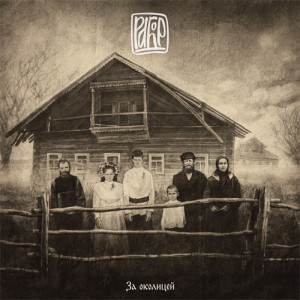 Rabor is a Moscow-based ensemble that currently makes ambient folk music based on old Russian folk ritual music. I say currently because until fairly recently they were part of the dungeon synth music scene, of which I knew absolutely nothing until I started preparing this review. I haven’t listened to any of their previous releases (although some are available online including on Bandcamp) along with others from the Russian C. O. D. label. They’ve moved in a more traditional direction, including polyphonic vocals and many folk instruments such as the gusli (a hammer dulcimer type lyre), hurdy-gurdy, domra (a round-bodied lute with three or four strings), mandolin, volynka (Russian bagpipes originally from Romania via the Volyn region of Ukraine) and many horns and folk wind and percussion instruments. On Beyond the Outskirts there are some subtle touches of atmospheric electronics and a lot of field recordings of animals and people, both between the tracks and as part of some musical selections.
Rabor is a Moscow-based ensemble that currently makes ambient folk music based on old Russian folk ritual music. I say currently because until fairly recently they were part of the dungeon synth music scene, of which I knew absolutely nothing until I started preparing this review. I haven’t listened to any of their previous releases (although some are available online including on Bandcamp) along with others from the Russian C. O. D. label. They’ve moved in a more traditional direction, including polyphonic vocals and many folk instruments such as the gusli (a hammer dulcimer type lyre), hurdy-gurdy, domra (a round-bodied lute with three or four strings), mandolin, volynka (Russian bagpipes originally from Romania via the Volyn region of Ukraine) and many horns and folk wind and percussion instruments. On Beyond the Outskirts there are some subtle touches of atmospheric electronics and a lot of field recordings of animals and people, both between the tracks and as part of some musical selections.
Altogether it’s an engaging blend of soulful folk and folk-inspired music. Some are old traditional songs and some are composed by the band. The traditional selections are folk songs that accompanied Russian peasants’ rituals, collected by ethnographers in the 1970s and ’80s in different regions of Russia, mainly in Rabor’s native Kostroma oblast. They have titles like “Loach On The Water” (the loach is a common Eurasian fish species), “Midnight Lady,” “Walking Around The Field,” and “Harvest Song.”
It has many familiar elements including the many folk instruments and the polyphonic vocals, but combined in unique ways: flutes, Jew’s harp, hurdy-gurdy and lots of strummed stringed instruments behind a large group of male and female voices on the stately 6/8 song “Wanderer” – a very catchy melody highlighted by insistent percussion and layer upon layer of drone. The aforementioned “Loach On The Water” has a similar time signature, beautiful harmony vocals and a flute melody that sometimes sounds Celtic. The instrumental “Na Erdani” is introduced by the sound of flowing water and rushing wind, followed by a flute and lute tune in 5/4 that eventually gives way to a more traditional 6/8, what I think of as the universal folk dance time signature.
All female voices (eventually joined by a few men) sing close harmony on the lilting march “Ileyu,” its rhythm laid down by feet walking in snow, and a simple arrangement of flutes and lyres. The beginning of “Walking Around The Field” sounds a bit like The Beatles’ “Good Morning,” with vocalizing from barnyard critters including chickens and roosters, barking dogs and lowing cattle, and a bagpipe and flute sketching out what sounds like an improvised tune in the background. (To my ear, none of the ambient sound inclusions come off as corny or ironic, but rather set the atmosphere for the song.) “Father Yegoriy” continues the rural soundscape in an off-kilter march, the song featuring mainly vocals with a few instruments commenting between the verses.
I have no idea who the personnel in Rabor are, how many there are, who the leader is, any of that. Fortunately, you don’t need to, to enjoy this lovely music. I don’t think I would enjoy dungeon synth music nearly as much, so I’m glad Rabor have shifted gears. Droning ritual folk music is much more to my liking, and Rabor does it well.
(C.O.D., 2023)
